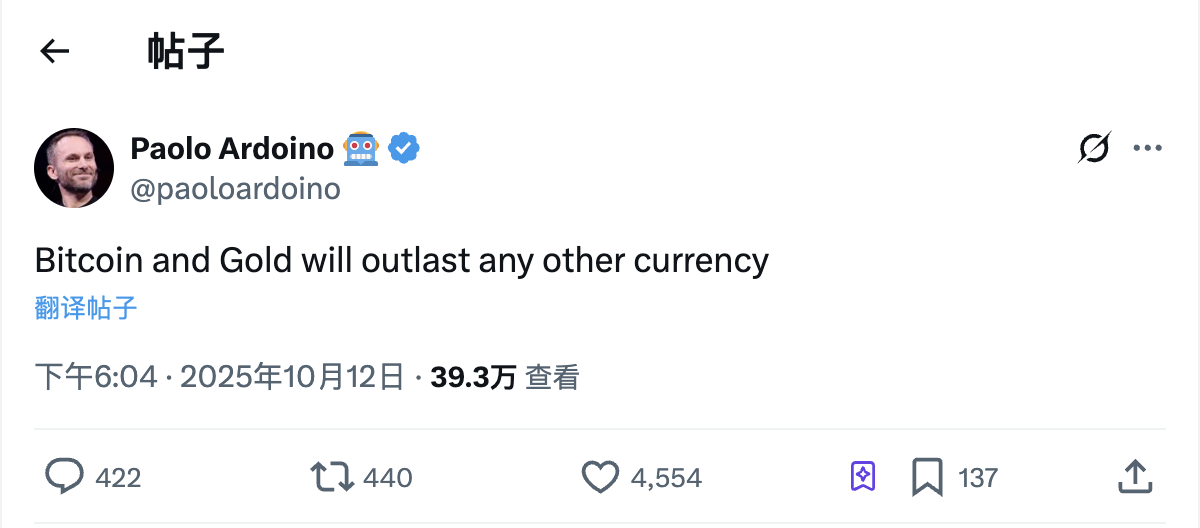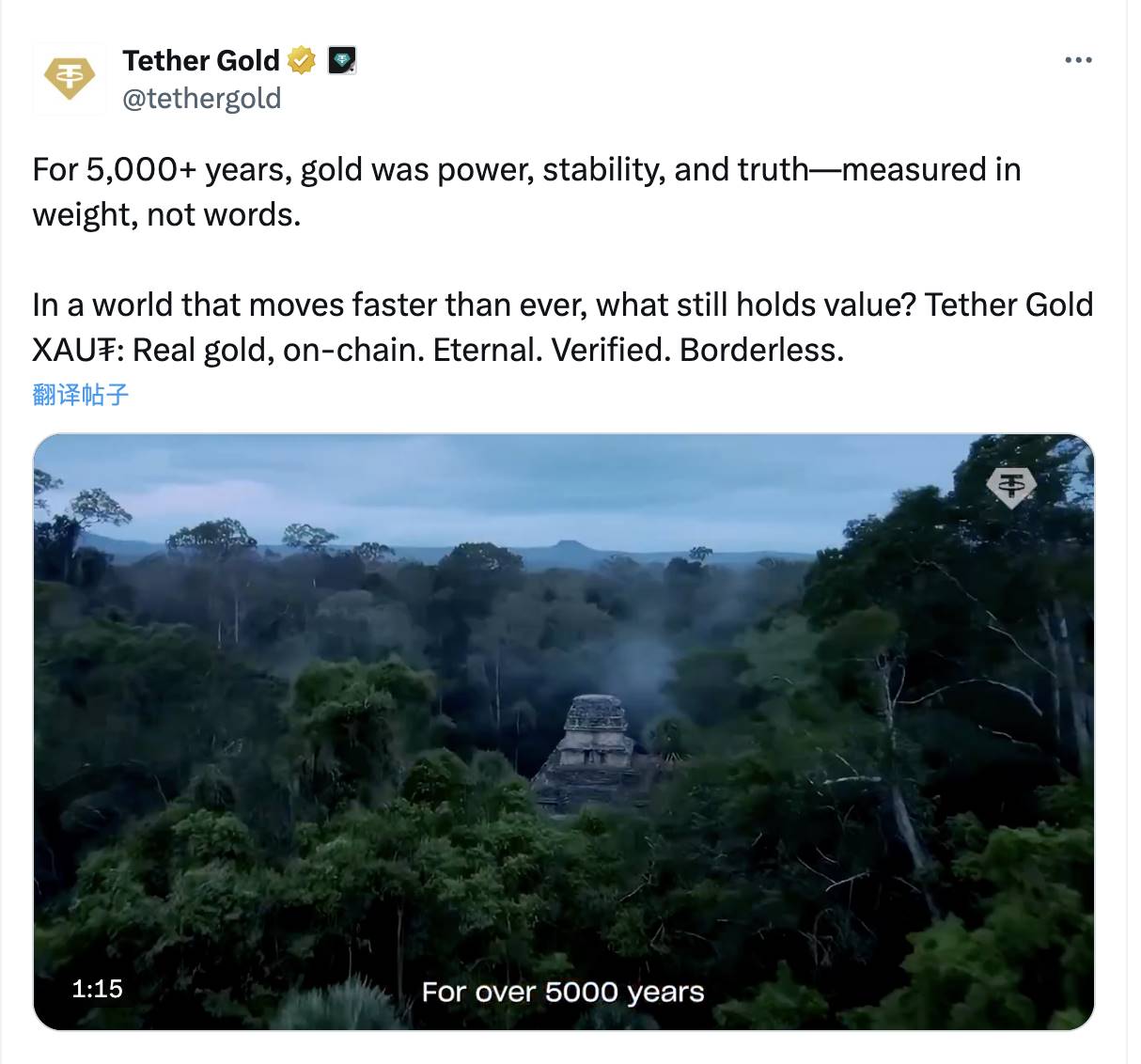Tether is not just simply buying gold; it has greater ambitions.
Written by: Liam, Deep Tide TechFlow
In 2025, global central banks are igniting an unprecedented gold-buying frenzy.
Central banks in countries such as China, India, Poland, and Turkey have collectively purchased over 1,100 tons of gold in the past year, setting a new record since the collapse of the Bretton Woods system.
However, amidst this gold resurgence, a "non-sovereign" buyer is quietly rising: Tether, the parent company of the stablecoin king USDT.
According to Bloomberg, Tether has become one of the largest gold buyers in the world. Its latest reserve report shows that as of September 2025, the gold held by the company is valued at over $12.9 billion, surpassing the central banks of several countries, including Australia, the Czech Republic, and Denmark, placing it among the top 30 globally.
Even more shocking is its pace of gold purchases. In the past year up to September, Tether has averaged over 1 ton of gold per week, ranking third in the global central bank system, only behind Kazakhstan and Brazil, and even surpassing the central banks of Turkey and China.
This does not even include the gold bar reserves corresponding to its gold-backed stablecoin (XAU₮) and private gold investments made with billions in profits.
Tether is not buying paper gold or ETFs; it is acquiring real gold bars.
Unlike most global central banks that store gold at the Bank of England or the New York Federal Reserve, Tether has chosen to build its own vaults and manage them independently. CEO Paolo Ardoino revealed in an interview that Tether has constructed "one of the safest vaults in the world" in Switzerland but refused to disclose its exact location.
Deep Tide TechFlow has learned that Tether is also building a second vault in Singapore to serve its Asian reserve business and the expansion of its gold-backed stablecoin XAU₮.
A crypto company is replicating the hardware infrastructure of central banks, creating its own vaults and a globally distributed reserve system.
Recently, Tether has taken an even more ambitious step by directly recruiting talent to enter the core hub of the gold market.
Bloomberg reported that Tether has hired two top global precious metals traders from HSBC: Vincent Domien, the global head of metal trading, and Mathew O’Neill, the head of precious metals financing for the EMEA region. Both are currently serving their notice periods and are expected to join in a few months.
Domien also serves as a director of the London Bullion Market Association (LBMA), which is the de facto standard-setting body for the global gold market. O’Neill has been with HSBC since 2008 and is a key figure in European precious metals financing.
Upon closer examination, it becomes clear that Tether is not just simply buying gold; it has greater ambitions.
From Gold Bars to Mines: Building a Full Industry Chain
If building vaults and hoarding physical gold is Tether's first step towards aligning with central banks on the "asset side," then its true ambition in gold goes far beyond being a passive buyer; it aims to integrate the entire gold industry chain into its financial landscape.
This landscape can be roughly divided into three layers: the bottom layer consists of gold mines and concessions, the middle layer consists of gold bars, and the top layer consists of tokenized on-chain gold.
First is the most familiar piece: XAUT, the gold standard written into smart contracts. Tether Gold (XAU₮) is a gold token launched by Tether, with each token corresponding to one ounce of physical gold, held in a Swiss vault and compliant with the LBMA's "Good Delivery" standards.
The latest official data reveals that XAU₮ is backed by approximately 370,000 ounces of physical gold, equivalent to over 11 tons of metal, all stored in Swiss vaults. With the surge in gold prices, the circulating market value of XAU₮ has surpassed $2.1 billion.
This means Tether has two layers of gold exposure:
One layer is the gold reserves recorded on its own balance sheet, which can also enhance the credit and risk resistance of the USDT stablecoin;
The other layer is the reserves behind the gold token XAU₮, which are restructured into financial products that can circulate on-chain.
For example, Tether has launched the open finance platform Alloy by Tether, allowing users to use XAUT as collateral to mint a new synthetic dollar stablecoin, aUSDT.
But Tether is not satisfied with this; it wants to go further in the gold industry chain, so it directly invests in upstream gold concession companies, incorporating future gold production from mines into its asset system.
In June 2025, Tether's investment entity, Tether Investments, announced its investment in the Canadian-listed company Elemental Altus Royalties, which focuses on gold and precious metals royalties and streams, owning rights to several producing or near-production mines.
Public information shows that through a series of agreements and stake increases, Tether could acquire over one-third of Elemental Altus's shares, becoming a "cornerstone shareholder" of this gold royalty company. It even plans to inject about $100 million in support of its merger with EMX Royalty, helping to create a mid-sized gold royalty platform.
Tether is not only buying gold bars that have already been mined but also acquiring rights to future gold extracted from the ground.
Tether is not satisfied with a single target; it is engaging with the gold industry on a broader scale. According to the Financial Times, Tether is in talks with several gold mining and investment companies, hoping to deploy capital across various segments of mining, smelting, trading, and royalty revenues, building its own "gold version of an industrial matrix."
It is reported that Tether has also had discussions with the gold mining investment tool Terranova Resources. Although no deal was reached, the signal sent is very clear:
Tether's goal is not simple financial investment but systematically connecting the gold industry chain.
Putting these pieces together, you will find that Tether's layout in gold presents a dual attack of "top-down + bottom-up":
From the top down, it starts from the financial product side, first establishing XAU₮ to meet global user demand for gold in a tokenized manner, creating a "gold traffic entrance";
From the bottom up, it gradually incorporates the asset side and supply side of the gold industry chain through investments and equity, starting from gold bar reserves, mining concessions, and potential mining investments.
Where Does the Faith in Gold Come From?
On the surface, Tether's bet on gold can easily be attributed to "gold FOMO, following central banks to buy safe assets."
But if we extend the timeline and review the public statements and asset adjustments of its executives over the past two years, you will find that this resembles a set of asset philosophy with a clear worldview:
Using Bitcoin and gold to forge a dual-pillar safety base for a "stateless central bank's" balance sheet.
Tether CEO Paolo Ardoino has mentioned on multiple occasions that he does not particularly like the phrase "Bitcoin is digital gold"; he prefers to express it the other way around, stating that gold is "natural Bitcoin": equally scarce, equally tested over time, just one exists in the physical world and the other in the digital world.
In September 2025, Ardoino stated, "As the world becomes increasingly dark, Tether will continue to invest a portion of its profits into safe assets such as Bitcoin, gold, and land." In his view, Bitcoin and gold will "outlive any fiat currency," serving as the ultimate value carriers across cycles.

As stated in the promotional video for XAU₮, for over 5,000 years, gold has symbolized power, stability, and truth, measured by weight rather than words.

Behind this is a series of actions Tether has taken on the asset side over the past two years:
On one hand, Tether's quarterly audit reports show that its asset reserves are highly concentrated in U.S. Treasury bonds, with its holdings of U.S. debt exceeding $120 billion, making it one of the largest single holders of U.S. debt globally;
On the other hand, starting in 2023, Tether has repeatedly emphasized in its announcements that it will use a portion of its quarterly profits to purchase "long-term value positions," first in Bitcoin and then in gold. The goal is not to provide a 1:1 collateral for USDT, but to strengthen the "hard asset" nature of the company's overall balance sheet to resist interest rate, credit, and geopolitical risks.
Therefore, Tether's bet on gold has at least several clear motivations:
The first layer is straightforward: turning profits into "something that cannot be printed by any central bank."
During the high-interest rate cycle, Tether earned over $10 billion in annual profits from its massive U.S. debt holdings, with profits expected to exceed $15 billion in 2025. But Ardoino is well aware that this "interest rate feast" is cyclical, while sovereign debt expansion is structural.
In the past year, he has repeatedly mentioned the so-called "devaluation trade," where investors, concerned about the long-term devaluation of sovereign debt and its denominated currencies, gradually shift their assets from government bonds and fiat currencies to hard assets like gold.
The second layer is to guard against extreme risks within the dollar system.
The size of USDT has grown to a level comparable to that of small national currencies and regional banking systems, which forces Tether to consider an extreme scenario: if at some point in the future, U.S. regulators or the banking system pressure or even freeze its assets, or if the entire dollar system encounters systemic risks, relying solely on U.S. debt and bank deposits would be too passive.
Gold does not belong to any sovereign credit and can be completely detached from traditional custody systems through self-built vaults. This is why Tether is building vaults in Zurich and Singapore, rather than storing gold for years at the Bank of England or the New York Federal Reserve like many central banks.
The third layer is that in the era of RWA (Real World Assets), gold is the most easily accepted off-chain asset.
In its Q1 2025 announcement, Tether explicitly described XAU₮ as "one of the largest market cap and most compliant tokenized gold products," emphasizing that all tokens are 100% backed by physical gold bars in Swiss vaults.
This creates a clever closed loop:
On one hand, Tether locks in the spot and long-term production exposure of gold through purchases and investments in royalty companies like Elemental Altus; on the other hand, it "slices" this gold using XAU₮ and puts it on-chain, transforming it into globally tradable, composable DeFi collateral and settlement assets.
From a business perspective, this is a re-DeFi-ification of the cash flow and valuation of the gold industry chain.
Every step of Tether's asset allocation resembles a company learning how to act like a central bank.
It is not just chasing returns; it is constructing a new order defined by code, anchored by gold and Bitcoin.
If the future indeed moves towards a multipolar currency system, then "U.S. debt + Bitcoin + gold" will not just be an asset portfolio but also the balance sheet of this "stateless central bank" traversing cycles.
免责声明:本文章仅代表作者个人观点,不代表本平台的立场和观点。本文章仅供信息分享,不构成对任何人的任何投资建议。用户与作者之间的任何争议,与本平台无关。如网页中刊载的文章或图片涉及侵权,请提供相关的权利证明和身份证明发送邮件到support@aicoin.com,本平台相关工作人员将会进行核查。




